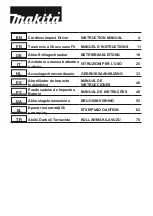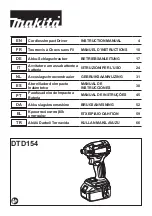
SW-Stahl und Werkzeugvertriebs GmbH
Tel. +49 (0) 2191 / 46438-0
www.swstahl.de
Leverkuser Straße 65
Fax +49 (0) 2191 / 46438-40
D-42897 Remscheid
E-Mail: [email protected]
- 10 -
Tightening Bolts and Nuts
1. Use the correct size socket. A larger socket
than needed will cause „rounding” of the bolt
and loose metal shaving to fly off.
2. Start slowly to engage and not damage the
threads. Once the thread is positively engaged,
the speed can be increased to facilitate the
work.
CAUTION: DO NOT push tool in a forward
direction against the fastener. Doing so will put
undue stress on the bearings and the
impression that the tool has lost some of its
power.
3. The proper torque can be reached in a
relatively short time. Stop the tools as soon as
the impact sound heard. When tightening
smaller nuts and bolts, carefully adjust
pressure on the power switch so that the nut is
not damaged.
NOTE: Since the torque is determined by many
factors (battery condition, size of socket, drive
extension used, nut and bolt condition, etc.), for
repeat operations, perform a torque test with a
torque wrench before use.
Removing Bolts and Nuts
Use the maximum torque available to remove
nuts and bolts. Be sure to slow the speed when
the fastener is nearly removed or the high rotation
speed will cause the fastener to “fly out“ and
cause damage of injury.
Factors Affecting Tightening Torque
1. Voltage: When the battery pack becomes
nearly discharged, the voltage decreases and
the tightening torque drops.
2. Tightening time: Longer tightening time
results in increased tightening torque.
Excessive tightening, however, adds no
value and reduces the life of the tool.
3. Different bolt diameters:
The size of the bolt diameter affects the
tightening torque. Generally, as the bolt
diameter increases, tightening torque rises.
4. Tightening conditions:
-Tightening torque may vary, even with the
same bolt, according to grade, length, and
torque coefficient (the coefficient indicated by
the manufacturer upon production).
-Tightening torque may vary, even with the
same bolting material (e.g. steel), according
to the surface finish.
5. Socket play: Torque is lowered as the hex-
socket is not used to tighten a blot.
6. Switch (Variable speed control trigger):
Torque is lowered if the unit is used with the
switch not fully depressed.






























